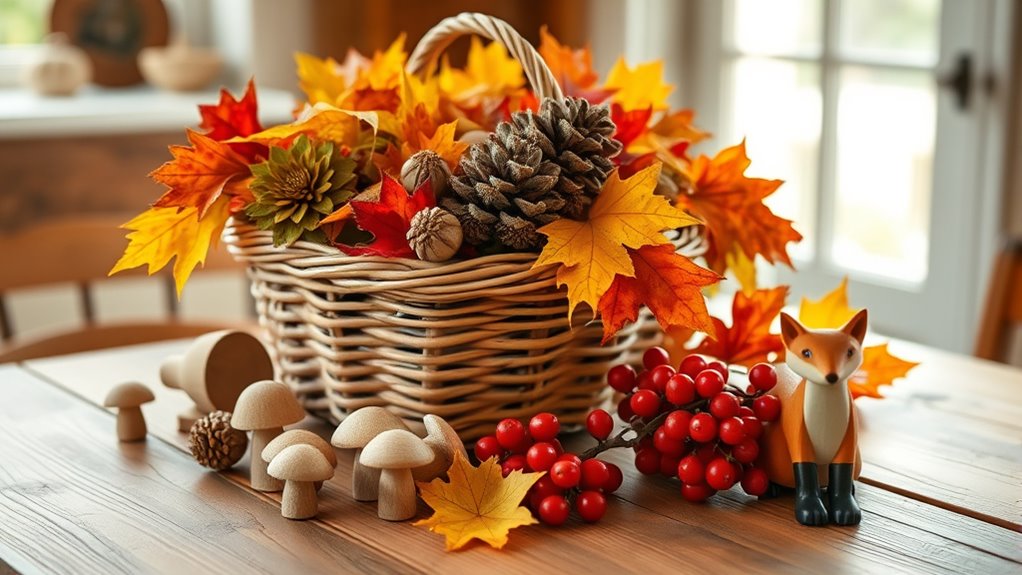To create a Waldorf seasonal nature table, choose a dedicated space like a table or shelf and regularly update it to reflect seasonal changes. Gather natural materials from outdoors, such as leaves, stones, flowers, or branches, and arrange them meaningfully to tell seasonal stories or evoke themes. Involve children in collecting and designing the display to deepen their connection with nature. Keep exploring for ideas on how to craft a beautiful, meaningful display that celebrates each season.
Key Takeaways
- Select a dedicated, accessible space like a table or shelf and update it seasonally.
- Gather natural materials from outdoors to reflect current seasonal changes.
- Arrange items thoughtfully to tell a story or evoke seasonal themes, using layering or small scenes.
- Incorporate meaningful decorations such as blossoms, leaves, or shells aligned with each season.
- Involve children in collecting and arranging materials to deepen their connection to nature and seasonal rhythms.

Creating a Waldorf Seasonal Nature Table is a wonderful way to connect children with the changing rhythms of the year. This simple yet meaningful activity transforms a designated space into a mesmerizing nature display that reflects the current season. By arranging natural materials and seasonal decorations, you invite children to observe, appreciate, and understand the cycles of nature. The key is to choose items that are meaningful and locally available, such as leaves, stones, flowers, or small branches, which become part of a living, evolving story on your table.
Start by selecting a dedicated surface—like a table, shelf, or windowsill—that will serve as your seasonal display. As the seasons change, update this space with appropriate decorations. For spring, think fresh blossoms, green moss, and budding twigs. In summer, incorporate seashells, bright flowers, and green foliage. For autumn, gather colorful leaves, acorns, and small pumpkins. During winter, use pinecones, evergreen sprigs, and smooth stones. The idea is to let nature’s own offerings inspire your decorations, making each change a gentle reminder of the passage of time.
Creating a Waldorf seasonal nature table involves more than just collecting objects; it’s about curating a meaningful arrangement that tells a story. You may choose to layer items, place them in small baskets, or create small scenes that evoke the essence of each season. For example, a tiny nest with eggs for spring, a miniature harvest scene for fall, or a cozy winter scene with pinecones and cotton for winter. This act of arranging becomes a tactile experience, engaging children’s senses and encouraging their observation skills. Incorporating natural elements can also deepen children’s understanding of the environment and foster a sense of connection.
Involving children in the process heightens the connection to nature and the rhythm of the year. Let them gather materials outdoors, encouraging mindfulness and respect for the environment. As they select and place each piece, they learn about the different seasons and develop a sense of appreciation for nature’s beauty. Seasonal decorations on the table serve as visual cues for storytelling and learning, helping children recognize the subtle changes happening around them.
Frequently Asked Questions
How Often Should I Update the Seasonal Nature Table?
You should update your seasonal nature table regularly, ideally every one to two weeks, to reflect seasonal changes and keep it fresh. This frequency allows you to observe seasonal reflections and adapt the display to the ongoing natural shifts. By doing so, you create a meaningful connection with nature, fostering awareness and appreciation. Consistent updates help maintain your table’s relevance and inspire ongoing curiosity about the changing seasons.
What Are Safe Materials to Include for Young Children?
Think of your nature table as a gentle garden for young explorers. You should include natural materials like smooth stones, dried flowers, and wooden figures—items that whisper stories through their textures. Always choose child-safe items, ensuring paints are non-toxic and surfaces are free from sharp edges. By selecting safe, natural materials, you create a cozy, inviting space where children can connect with nature safely and joyfully.
Can I Incorporate Artificial or Preserved Items?
You can incorporate artificial accents and preserved elements into your seasonal nature table, but do so thoughtfully. These items add visual interest and longevity, making your display more durable and vibrant. Just guarantee they complement natural materials and aren’t overwhelming. Use preserved elements sparingly to maintain the table’s connection to nature. Always prioritize safety, avoiding any items with small parts or harmful chemicals, especially around young children.
How Do I Teach Children About Seasonal Changes Through the Table?
You teach children about seasonal changes on the table by engaging them in nature-inspired crafts and sensory exploration. Encourage them to observe and collect natural items like leaves, flowers, or stones that reflect the current season. Use these to create displays, discuss how they change, and explore textures and scents. This hands-on approach helps children connect with nature’s cycles, fostering curiosity and a deeper understanding of seasonal transformations.
What Are Some Creative Display Ideas for Small Spaces?
You can maximize small spaces by creating miniature landscapes that showcase seasonal changes, adding charm and educational value. Use DIY crafts like tiny trees, animals, and seasonal symbols to make the display lively. Arrange these elements thoughtfully on a small table or shelf, layering textures and colors to reflect the season. This approach keeps the display engaging and visually appealing, making the most of limited space while inspiring curiosity about nature’s rhythms.
Conclusion
As you step back to admire your Waldorf seasonal nature table, imagine the gentle glow of sunlight illuminating the tiny leaves, delicate feathers, and smooth stones you’ve gathered. It’s a living tapestry that invites you to slow down and notice the subtle changes in nature. Each piece tells a story of the season’s rhythm, reminding you to cherish the quiet beauty around you. Your table becomes a peaceful window into the ever-changing dance of the natural world.










